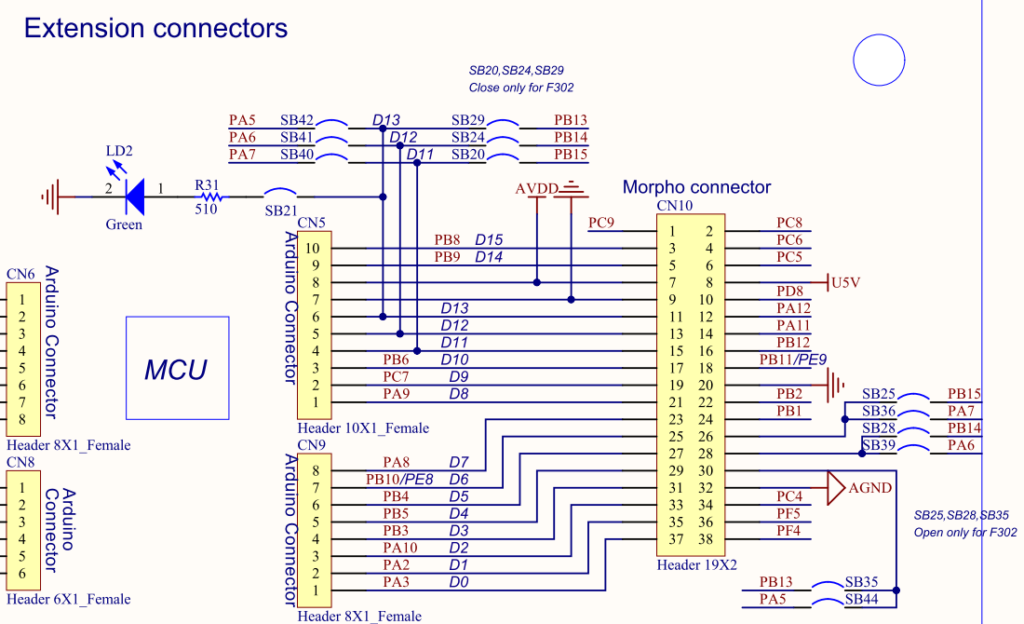

- #GPIO PINS ON NUCLEO F401RE HOW TO#
- #GPIO PINS ON NUCLEO F401RE FULL#
- #GPIO PINS ON NUCLEO F401RE CODE#
- #GPIO PINS ON NUCLEO F401RE FREE#
I tend to use Ethernet connection during development then move over and test with WIFI when I need to. Nucleo-L476 for a low energy alternative for the F401. Nucleo-F446, smaller footprint board, no Ethernet perhaps better if you want to use external WIFI or GSM. These are crazy fast for a micro-controller and very reasonably priced. Nucleo-F767 and H743 for the faster not so energy efficient projects. Some hardware advice from someone who has just too many board’s TLS, SSL simply eats resources, so regarding your last comment to buy the L476, I may have a go with that example you tried, but the problem is Mbed is very security orientated and does highly recommend Targets with embedded TRNG capability. I did have another try with the F401 using my Firebase example and had the same result, error -3011 when trying to connect with TLS. I am still left with pretty much ~35KB of RAM (using peak usage).ĭo you have any indication that it is RAM related? Maybe any logs while you were trying TLS to see where it hangs? For what I know, that micro can run a bunch of algorithms, see some benchmarking results I got: Say I perform an HTTPS request and I need 4K+1.5K+50K= 55.5K. RAM> Used: 4144 B | Memory Region: 96 KB | %age used: 4.22% Implies that there is a network interface occupying memory (like lwIP or some network.c interface I suppose).įrom my RAM at compilation (mind you, I have 2xUARTS, ADC, DMA, various interrupts and RTC enabled) This means that you cannot use HTTPS on devices with less than 128K of memory, asyou also need to reserve memory for the stack and network interface. HTTPS requires additional memory: on FRDM-K64F about 50K of heap space (at its peak). If you need to handle requests that return a large response body, see ‘Dealing with large body’. When the request is finished they require 1.5K of RAM, depending on the size of the response. Small requests where the body of the response is cached by the library (like the one found in main-http.cpp), require 4K of RAM. One question though, from the linked post I read: Memory usage To be honest, I havent looked at RAM usage at all. Hello Paul and thank you very much for your input.
#GPIO PINS ON NUCLEO F401RE FREE#
In the meantime, If you have any comments on my post, please feel free to provide any feedback. I will review support’s responses because it looks like most of the issues there are similar to mine and PEBCAK. I was browsing the forum and came across this. #define MBEDTLS_X509_CHECK_EXTENDED_KEY_USAGEĪny input would be really appreciated. #define MBEDTLS_ECP_DP_CURVE25519_ENABLED #define MBEDTLS_NO_DEFAULT_ENTROPY_SOURCES I also provide my config file for reference:
#GPIO PINS ON NUCLEO F401RE FULL#
I am currently not looking at full mbed OS implementation, which has a lot of functionality, but I cannot integrate with the rest of my code. What am I missing and instead of getting any response from the server, I am getting the same response either with or without my module connected to it? I even tried to go PPPoS to leverage sockets and so on but to be honest it is discouraging from scratch, at least for my level.

#GPIO PINS ON NUCLEO F401RE HOW TO#
#GPIO PINS ON NUCLEO F401RE CODE#
Also, the code is based on this example)Ĭustom_print("Parsing public key.\r\n") So far, I am able to create an SSL context, and parse the public key, as well as root CA like so (please ignore the custom ugly prints.Also, I hope that this post helps others in similar position. I will try to do a quick sum-up of where I am and where I am stuck. I am trying to use it with bare metal STM32 Nucleo-F401RE and a SIM800 GSM modem for HTTPS GET/POST. First of all thanks for providing mbedTLS.


 0 kommentar(er)
0 kommentar(er)
